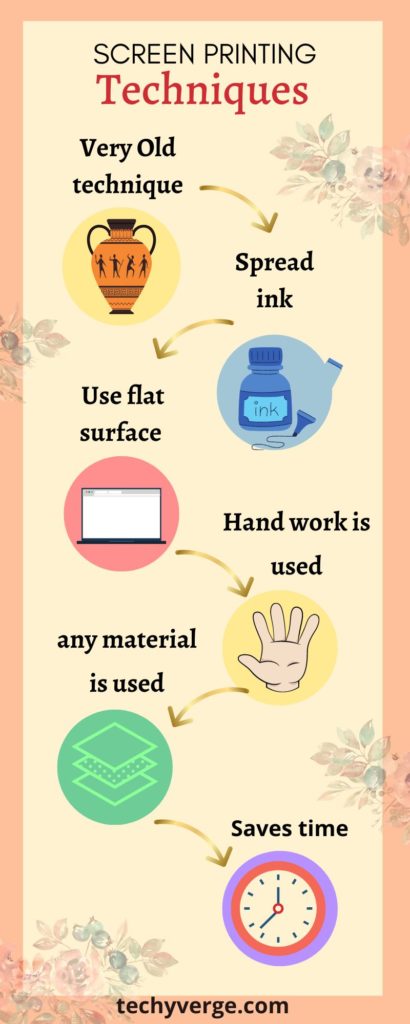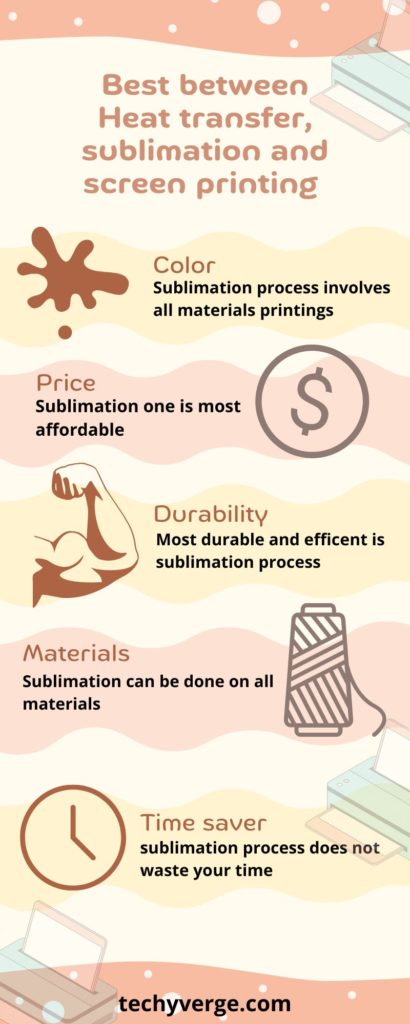Are you familiar with the fascinating world of printing methods? If not, let me introduce you to the captivating trio of Heat Transfer, Sublimation, and Screen Printing. These techniques are widely used to apply dyes and create stunning prints.
In this article, we will explore the main differences between Heat Transfer, Sublimation, and Screen Printing, and delve into the unique processes that make each one a remarkable choice for durable and high-quality prints.
Key Points:
- Heat Transfer, Sublimation, and Screen Printing are three popular methods for applying dyes and creating prints.
- Each method utilizes a distinct process to achieve remarkable results.
- Sublimation involves a chemical reaction between ink and polyester fibers, resulting in vibrant prints in a short amount of time.
- Heat Transfer permanently attaches materials using heat and pressure, ensuring long-lasting prints.
Feature of Heat Transfer vs Sublimation vs Screen Printing
You can better understand the features of these products by making a slight comparison. At first, we will compare the Dye sublimation and screen printing processes and then the Heat transfer mechanism. We will ensure that you can easily pick the best product among these three by reading our content.
Why Dye Sublimation?
Dye Sublimation is a unique process that involves the printing mechanism without the use of water. It includes the use of special inks and a heat press so that you can easily create your perfect designs.
In Sublimation, a design is first printed in its mirror image. Secondly, it is placed in a heat press using transfer papers. This heat press allows the ink to pass through to its gas form.
After attaching to the surface of the materials, these gas vapours are released. This leads to a permanent impression of your design on the materials. People generally use the Dye Sublimation process because it is not very expensive.
Moreover, it provides fully customised designs with the best quality. It can stand against Bleach, sunlight, and water. This whole product is eco-friendly and produces no harmful products. It can last longer than any other designs produced by other processes. Now, let us look at why this process is better than all others.
Why is Dye Sublimation different from Heat Transfer and Screen Printing?
Dye sublimation is different from these processes because of its quality and features. These are pretty affordable than these other products. Dye sublimation allows you to print your images fully on all materials in the presence of polyester coatings.
It does not require a high temperature like the heat transfer process. Compared to screen printing, it can also be more efficient. Therefore, people usually choose the Dye Sublimation process for printing designs.
Why Screen Printing?
For creating new designs, screen printing is an ancient printing technique. With it, you can print anything you like on your materials wherever you want.
It involves a machine or hand, a screen, and printing material. First, the ink is spread on the whole screen. Then, using either hands or machines, the ink is squeezed through the screen.
Beneath the screen, the material to be printed is present. All the squeezed ink passes through the screen and attaches to the surface of the materials. You make a perfect impression of your designs on the material’s surface.
People love to use this process for printing their handmade creative designs. That is why it is said to be the most popular printing process among all the other processes.
Here are some of the best features of this process. Why do people from all over the world choose this over the heat transfer and sublimation process?
Why is Screen Printing different from the Heat Transfer and Sublimation process?
Firstly, screen printing is the most affordable and straightforward process among these three processes. It does not require high temperature, pressure, or transfer papers like in the heat transfer process.

Secondly, it is different from the sublimation process using its print. The ink of Screen printing directly attaches to the upper surface of the material.
Sublimation, on the other hand, makes the gas vapours attach to the material’s surface. Screen printing is more efficient than this.
Why Heat Transfer?
The heat transfer mechanism works in the presence of high pressure and temperature. Your materials can be designed to perfection with it.
There is one transfer source that you can choose from. This includes Vinyl and Digital heat transfer. Vinyl is the most used heat transfer material. These Vinyl materials are transferred directly to the clothes at high pressure.
Digital ones, however, aren’t as efficient as vinyl. However, they include the use of solvents and inks. Thus, they are transferred to materials entirely at the same time.
This process can add more than one colour to your design. It will make it look more elegant and attractive. It produces high-quality images and takes less time to do it.
Therefore, people prefer this process to other printing processes. They benefit from this because they can save time and produce high-quality images. Now, let us see why they are different from other printing processes.
Why is Heat Transfer different from Screen Printing and Sublimation processes?
The main reason that heat transfer is different from screen printing is that it can save time. Screen printing is a slow process, and it includes the use of some colours.
While heat transfer is a rapid mechanism that occurs in the presence of high pressure and temperature. Sublimation may cost you less compared to the heat transfer process.
Although it includes special sublimation printers, sublimation inks, heat presses, and transfer papers. But, along with this, a large time is also required to set these whole items for the printing process fully.
Which is the best Printing process of these 3 Processes?
We can easily find out what printing process is the best by looking at some features.

Price
The first main thing in comparing these three printing processes is their price. The heat transfer process normally costs more than all other processes. It may cost you around $300.
Screen printing involves only a few items, but it costs more than the sublimation process. Sublimation is the most affordable or cheap printing process among these 3.
Thus, dye sublimation is the best printing process according to the price of heat transfer and screen printing processes.
Materials
The dye sublimation process can only work on materials that are either polyesters or have polyester coatings. They can not print designs on Cotton materials.
Screen printing can only print on cotton materials. They can not print designs on any other materials other than cotton ones. In the end, the heat transfer process is the only process that can print on any type of material.
However, using different products, you can print on nearly all types of materials in sublimation printing. Therefore, dye sublimation is also said to be the best printing source for creating new designs through a heat transfer and screen printing.
Colours
Screen printing involves printing on only dark-coloured materials. The heat transfer can only print on light-coloured materials. The sublimation process also involves printing on light-coloured materials.
However, a special polyester coating is available that helps you to print in nearly all types and colours of materials. Therefore, you can see that the dye sublimation process also has value in all the other printing processes.
FAQs ( Heat Transfer vs Sublimation vs Screen Printing)
The main difference lies in the method of applying dyes. Heat Transfer uses heat and pressure to permanently attach materials, Sublimation involves a chemical reaction with polyester fibers, and Screen Printing uses screens to transfer ink onto surfaces.
Sublimation is known for creating vibrant prints due to the chemical reaction between ink and polyester fibers. It also provides long-lasting results.
Yes, Heat Transfer can be used on various materials, including fabrics, ceramics, and metals, making it a versatile printing method.
Sublimation is the ideal choice for printing on polyester fabrics, as it creates a strong bond between the ink and the fibers, resulting in vibrant and durable prints.
Yes, Screen Printing excels in reproducing complex designs and multicolored prints, making it a preferred method for intricate artwork.
Sublimation is a relatively fast process, as the chemical reaction between the ink and polyester fibers occurs quickly, allowing for efficient production.
Conclusion:
In conclusion, when it comes to Heat Transfer vs Sublimation vs Screen Printing, each method offers its own set of advantages.
- Heat Transfer allows for the permanent attachment of materials, ensuring durability.
- Sublimation creates vivid prints through a chemical reaction with polyester fibers, providing vibrant and fast results.
- Screen Printing, on the other hand, offers versatility and the ability to print on various surfaces.
Whether you’re seeking vibrant colors, durability, or versatility, understanding the differences between Heat Transfer, Sublimation, and Screen Printing will help you choose the perfect method for your printing needs. So go ahead, explore the world of printing techniques, and unleash your creativity!
- Can You Sublimate on Nylon and Polyester? Which oneis the Best - February 19, 2024
- Converted Epson Eco Tank Et-2800 Vs Et-2803 Sublimation Printer [Review 2024] - February 19, 2024
- Can You Reuse Sublimation Prints? (The Righ Answer) - February 19, 2024




![Top 100+ FAQs Related to Sublimation Printing & Heat Press [Updated 2024] faqs related to sublimation Printing](https://www.techyverge.com/wp-content/uploads/2022/08/faqs-related-to-sublimation-Printing--150x150.jpg)

